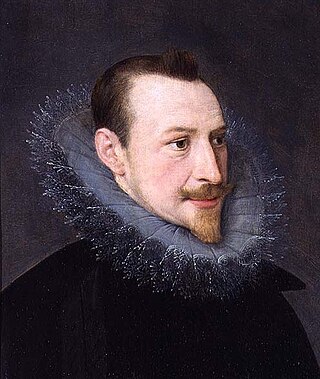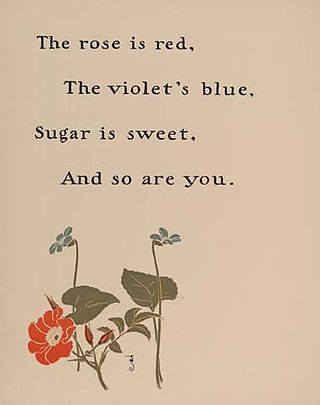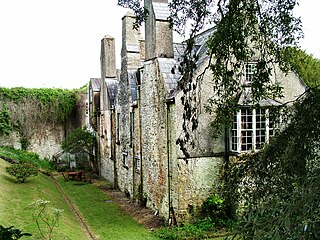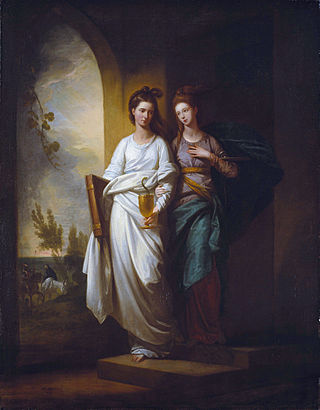Related Research Articles

Edmund Spenser was an English poet best known for The Faerie Queene, an epic poem and fantastical allegory celebrating the Tudor dynasty and Elizabeth I. He is recognized as one of the premier craftsmen of nascent Modern English verse, and he is considered one of the great poets in the English language.

The Faerie Queene is an English epic poem by Edmund Spenser. Books I–III were first published in 1590, then republished in 1596 together with books IV–VI. The Faerie Queene is notable for its form: at over 36,000 lines and over 4,000 stanzas, it is one of the longest poems in the English language; it is also the work in which Spenser invented the verse form known as the Spenserian stanza. On a literal level, the poem follows several knights as a means to examine different virtues, and though the text is primarily an allegorical work, it can be read on several levels of allegory, including as praise of Queen Elizabeth I. In Spenser's "Letter of the Authors", he states that the entire epic poem is "cloudily enwrapped in Allegorical devices", and that the aim of publishing The Faerie Queene was to "fashion a gentleman or noble person in virtuous and gentle discipline".
The Spenserian stanza is a fixed verse form invented by Edmund Spenser for his epic poem The Faerie Queene (1590–96). Each stanza contains nine lines in total: eight lines in iambic pentameter followed by a single 'alexandrine' line in iambic hexameter. The rhyme scheme of these lines is ABABBCBCC.
Fairyland (Early Modern English: Faerie; Scots: Elfame in English and Scottish folklore is the fabulous land or abode of fairies or fays. Old French faierie referred to an illusion or enchantment, the land of the faes. Modern English fairy transferred the name of the realm of the fays to its inhabitants, e.g., the expression fairie knight in Edmund Spenser's The Faerie Queene refers to a "supernatural knight" or a "knight of Faerie" but was later re-interpreted as referring to a knight who is "a fairy".

"Roses Are Red" is the name of a love poem and children's rhyme with Roud Folk Song Index number 19798. It has become a cliché for Valentine's Day, and has spawned multiple humorous and parodic variants.
Anthony Copley (1567–1609) was an English Catholic poet and conspirator. He reproached the Jesuits and their meditations on martyrdom, and loyally praised Queen Elizabeth. He is principally known to posterity for his long allegorical poem in 1596 opposing voluntary death, in parody of Book I of The Faerie Queene, entitled A Fig for Fortune; it has been considered a contribution to the same tradition as Hamlet.
David Lee Miller is a scholar of English Renaissance Literature. He is Distinguished Professor of English and Comparative Literature at the University of South Carolina in Columbia. His works include The Poem's Two Bodies: The Poetics of the 1590 Faerie Queen, ; Dreams of the Burning Child: Sacrificial Sons and the Father's Witness ; three edited books; and about two dozen refereed articles that have appeared in scholarly journals such as Modern Language Quarterly, English Literary History, and Publications of the Modern Language Association. He is one of four general editors of The Collected Works of Edmund Spenser, a new scholarly edition under contract to Oxford University Press.

Saint George and the Dragon is a book written by Margaret Hodges and illustrated by Trina Schart Hyman. Released by Little, Brown, it was the recipient of the Caldecott Medal for illustration in 1985. The text is adapted from Edmund Spenser's epic poem The Faerie Queene.
John Upton was an English clergyman, academic and critic. An important early editor of Edmund Spenser, he is best known for the notes in his 1758 edition of Spenser's great romance epic The Faerie Queene, which was first published in 1590 and 1596.

Myrtle Grove is an Elizabethan gabled house in Youghal, County Cork, Ireland. The house is notable as a rare example in Ireland of a 16th-century unfortified house. It is situated close to the Collegiate Church of St Mary Youghal.
Orgoglio is a literary character in Edmund Spenser's famous epic The Faerie Queene. He appears in the seventh canto of Book One as a beast and attacks the main character, Redcrosse, who symbolizes the ultimate Christian knight, during a moment of weakness. "Orgoglio" means "pride" in Italian. In chapter IX of Waverley, by Sir Walter Scott, the manor of Bradwardyne is compared to the castle of Orgoglio.
— From Sir John Harington, A New Discourse of a Stale Subject, called the Metamorphosis of Ajax

The Palace of Pleasure is a poem by James Henry Leigh Hunt published in his 1801 collection Juvenilia. Written before he was even sixteen, the work was part of a long tradition of poets imitating Spenser. The Palace of Pleasure is an allegory based on Book II of Edmund Spenser's The Faerie Queene and describes the adventure of Sir Guyon as he is taken by airy sylphs to the palace of the "Fairy Pleasure". According to Hunt the poem "endeavours to correct the vices of the age, by showing the frightful landscape that terminates the alluring path of sinful Pleasure".
John Longe (1548–1589) was an English-born Church of Ireland archbishop of Armagh. He had a fondness for good living, which caused him to run up massive debts, but was also noted for his literary tastes.

Samuel Croxall was an Anglican churchman, writer and translator, particularly noted for his edition of Aesop's Fables.
Sir Thomas Copley (1534–1584) was a prominent English Roman Catholic politician and exile of the reign of Elizabeth I. Knighted, perhaps by the king of France, and created ennobled by Philip II of Spain, he was often known by contemporaries as "Lord Copley".
The House of Pride is a notable setting in Edmund Spenser's epic poem The Faerie Queene. The actions of cantos IV and V in Book I take place there, and readers have associated the structure with several allegories pertinent to the poem.
The Political and Ecclesiastical Allegory of the First Book of the Faerie Queene is a book written by Frederick Morgan Padelford to explain the allegories within the poem The Faerie Queene by Edmund Spenser. The book was first published in 1911 in Boston by Ginn and Company as part of a series of University of Washington publications. The book has been republished since and is widely cited in papers and books related to the study of Spenser and his works.

Fidelia and Speranza is a 1776 painting by Benjamin West. It is a neoclassical depiction of a scene from the poem The Faerie Queene by Edmund Spenser.
Rose Mary Freeman was a British scholar of English literature, a reader at Birkbeck College, and a specialist in Edmund Spenser. She won the British Academy's Rose Mary Crawshay Prize in 1951.